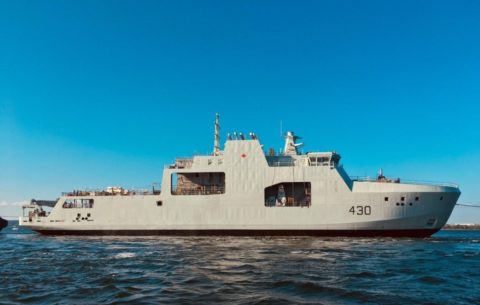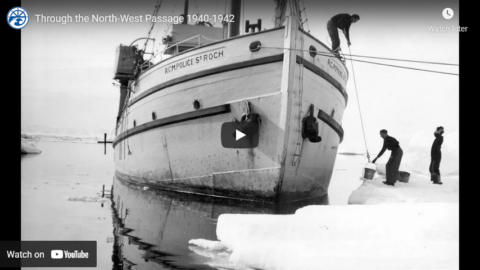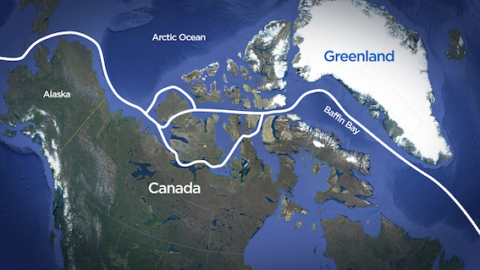Royal Canadian Navy / Marine Royale Canadienne
Published 7 Mar 2022Akuni aullarsimaniq (ᐊᑯᓂ ᐊᐅᓪᓚᕐᓯᒪᓂᖅ) Inuktitut for “A long journey”.
Imagine the adventure! For the crew of our first Arctic and Offshore Patrol Vessel, HMCS Harry DeWolf, their inaugural deployment circumnavigating North America from August to December 2021 presented many unique and life-changing experiences.
March 8, 2022
HMCS Harry DeWolf goes INTO THE NORTH
January 11, 2022
Through the North-West Passage 1940-1942
Vancouver Maritime Museum
Published 21 Aug 2020in 1942, the St. Roch became the first vessel to complete the west-east traverse of the Northwest Passage. This documentary chronicles the historic journey. This film was prepared in 1942 for the R.C.M.P. by Cst. F.S. Farrar, first mate of St. Roch from 1930-34 and 1938-43.
November 23, 2021
Conquering the Arctic: HMCS Labrador and her air wing, the Piasecki HUP-3 Retriever and Bell HTL-4
Polyus Studios
Published 10 Nov 2021Support me on Patreon – https://www.patreon.com/polyusstudios
In 1954 the Canadian military deployed its first and only icebreaker. With it they would help to secure sovereignty over the Arctic and map the fabled Northwest passage. It was the first deep-draught ship to transit the Northwest Passage and the second vessel ever to accomplish the feat in one season.
HMCS Labrador‘s contributions to opening up sea navigation in Canada’s Arctic were monumental. In four years of operating in dangerous and uncharted waters she never ran aground or was seriously damaged in any way. She explored and charted thousands of kilometres of coastline in some of the least hospitable places in the world. Its faithful helicopters pushed the limits of what was possible with a ship at sea.
While almost forgotten today, HMCS Labrador and her Peasecki HUP-3, and Bell HTL-4 helicopters helped to shape Canadian sovereignty to this day.
0:00 Introduction
0:31 Quest to secure Canadian arctic sovereignty
3:05 HMCS Labrador is built to assert sovereignty over the Arctic
5:19 Bell HTL-4
5:58 Piasecki HUP-3 Retriever
7:12 Deployment history
12:59 HMCS Labrador retired from RCN
13:57 Retirement of HUPs and other uses
14:51 Retirement of HLTs, and other uses
15:17 ConclusionMusic:
Denmark – Portland Cello ProjectResearch Sources:
Footage Sources:
BOLD JOURNEY ROYAL CANADIAN NAVY LABRADOR THROUGH NW PASSAGE – https://youtu.be/B7wOv5s0-F4#Arctic #CanadianAerospace #PolyusStudios
October 7, 2021
Understatement alert – “… many Canadians are less than confident in our prime minister’s ability to defend Canadian interests when up against Xi Jinping”
In The Line, Jaclyn Victor discusses Canada’s longstanding military freeloading habits and how Chinese interest in the Arctic are only the latest concerns pushing the government to start taking national sovereignty seriously:

Arctic Offshore Patrol Ship HMCS Harry DeWolf shortly after launch in 2018. The ship was commissioned into the Royal Canadian Navy in June, 2021.
If the West has learned anything about China in recent years, it’s that its leaders will stop at nothing to advance their interests, and will often do so in unpredictable ways. For Canada, the most obvious lesson here was the brazen hostage diplomacy that saw “the two Michaels”, Kovrig and Spavor, imprisoned for nearly three years in retaliation for Canada’s detention of Huawei executive Meng Wanzhou. But there’s another area in which China is flexing its muscles that is much closer to home: the Arctic.
Despite being nearly 1,500 kms from the Arctic Circle, China claims to be a “near-Arctic” state. This alone might not be concerning if it weren’t also for China’s efforts to increase its Arctic presence while simultaneously undermining that of legitimate Arctic states. Although Canada staunchly claims to have sovereignty over the Northwest Passage, China hasn’t accepted this, yet has (concerningly) demonstrated an increased interest in the Arctic. Canada’s periodic military exercises and lack of assertion in the North are clearly not effective in dissuading Chinese interest in the region. As the world recognizes the importance of the Arctic we must do more if we want to maintain our influence.
From claims that Trudeau has personal ties to the Chinese Communist Party to the general belief that he has no backbone in Chinese foreign policy matters, it is clear that many Canadians are less than confident in our prime minister’s ability to defend Canadian interests when up against Xi Jinping. Perhaps the most relevant example of this is the release of the Two Michaels after nearly three years in Chinese captivity — a momentous occasion that filled many Canadians with a renewed hope — but only happened thanks to support from President Biden. And what about China’s alleged election interference, which was aimed at supporting the Trudeau Liberals at the expense of the more hawkish Erin O’Toole? Simply put, China wouldn’t want Trudeau in power if they thought he’d put a damper on their interests.
Our allies, unfortunately, also recognize that our inaction is no match for China’s “coercive diplomacy” and military preparedness. Canada could have contributed to, and hugely benefited from, the recently signed AUKUS pact. The agreement was largely intended to provide Australia with nuclear submarines to fend off Chinese aggression, but it also committed the partners to collaborate on AI and other technologies. Canada seems to have been deliberately excluded. We’re skilled in many of the information-sharing focus areas specified in the agreement, and we clearly need increased submarine capabilities in order to help maintain the Arctic sovereignty we claim to have. On top of this, many of our closest allies have outright denied Canadian claims to the NWP, leaving us with limited defence partnerships as they relate to the Arctic.
In the meantime, China has been establishing itself in the Arctic in an effort to get a foothold. In 2018, China’s Arctic Policy was published — the first of its kind for an Asian state. The policy, which discusses Chinese interest in Arctic resource extraction, brings light to Chinese efforts to develop industry in the region. China currently controls about 90 per cent of the global trade of rare minerals, and they want to maintain this dominance. As Arctic ice melts and additional resources become accessible, one can bet that China will want a piece of the pie. China already has a robust starting point for strategic investments, with US $19 billion invested in Canadian Arctic mining projects. Until the NWP (or “golden waterway” as it’s been called) becomes ice-free in the summers, China will likely continue seeking additional investment opportunities to increase its hold and resulting influence. Once the strait inevitably becomes easy to transit, China will already have a legitimate reason to do so.
July 18, 2019
Canada’s disputed claims to the Arctic
In the Post Millennial, Jason Unrau writes about the Canadian government’s largely unsupported claims to the Northwest Passage as Canadian territorial waters:
If Canada is serious about defending sovereignty over its Arctic archipelago, Ottawa needs to develop better infrastructure there and start with a permanent military base, says the only MP who attended the International Arctic Forum held in St. Petersburg, Russia.
“The conversation was that it’s international waters. From a Canadian perspective we lay claim to it, but the international community is really looking at it as international waters,” said David Yurdiga, Conservative MP for Fort McMurray–Cold Lake Alberta.
“There are plans to open up the Northwest Passage and connect it as part of international shipping lanes, as they call it … even the U.S. says it’s international waters.”
Canada’s jurisdiction over the waterway was last publicly questioned at the meeting of Arctic Council nations in Finland, where U.S. Secretary of State Mike Pompeo called Canada’s claim “illegitimate”.
[…]
But back in the real world, nobody cares about Canada’s claims to our Arctic archipelago, except for us, said Yurdiga. And barely a month before Scheer and Freeland duked it out on Twitter, in St. Petersburg, according to Yurdiga, only department staff attended the International Arctic Forum – not MPs, nor ministers.
“I was really shocked there was no representative from the government,” Yurdiga said. “We have international communities talking about these as international waters, and we have nobody from the Canadian government pushing back on our sovereignty. We’ve got to be an active player.”
May 23, 2016
QotD: Yachting news
It is pleasing to see a man travelling in style. Erkan Gürsoy, age sixty-eight, took the northern route for his latest visit to his native Turkey, which is usual when flying to the Old World from British Columbia. But he gave this a twist by avoiding the airlines. Instead he negotiated the Northwest Passage, then crossed the rough Atlantic (weathering a hurricane), in a 36-foot aluminum yacht of his own construction. The Altan Girl, and her master, arrived safely at Çanakkale (near Troy in the Dardanelles), somewhat dimpled by the ice. Polar bears were also among Mr Gürsoy’s perils, as I gather from reports.
Most solo sailors come from inland locations, I have noticed, and this one from the Turkish interior. My theory is that people raised along the coast would know better. My own frankly escapist sailing fantasies owe much to a childhood spent mostly well inland, so that I was fully four years before I’d even seen an ocean. I remember that first encounter vividly. It turned out to be larger than I had expected.
Mr Gürsoy makes his living in Nanaimo manufacturing aluminum boats, mostly as tenders for larger vessels. He calls his stock-in-trade the “non-deflatable” — the hulls ringed around with fat aluminum irrigation tubing. He has a patent on that, and while admitting that his craft are rather ugly, notes that they are hard to sink. (From photographs I see that he is not much into concealing welds, either.) They are also rather noisy, for those riding inside, and they do bounce about on the waves. But on few other ships can one drum so impressively, to discourage those pesky bears, when trapped in ice that is crushing you like a pop can.
Clearly, from the accounts I have read, and by the full Aristotelian definition, a magnificent man.
David Warren, “Yachting news”, Essays in Idleness, 2015-02-11.
February 24, 2015
A Victorian-era effort equivalent to a moon landing in the 20th century
At sp!ked, Alexander Adams tries to put the Franklin Expedition into a context we can understand:
In May 1845, two Royal Navy ships, HMS Terror and Erebus, embarked from London on a voyage with ambitious aims. The mission would forge a passage through the partially mapped channels of northern Canada and pioneer the Northwest Passage. This route from Greenland to Alaska via the icy channels on the Arctic Circle would open new trading routes and allow vessels to forgo the dangerous and lengthy passage around Cape Horn. The attempt would use new technology pioneered in Britain — coal-fired engines powering propeller screws for locomotion, and tinned food.
The Admiralty decided on a large party in two ships under the command of Arctic veteran Sir John Franklin. Hostile conditions, the use of new technology, and — critically — operating beyond immediate assistance of the few trading forts and whaling stations to the south, meant the expedition was the equivalent of a Victorian-era moon landing. If men, supplies, technology, knowhow or leadership failed, then deaths could be expected. However, experience suggested that if the attempt met insurmountable obstacles there was a fair chance of retreating with only minor casualties, if leadership was decisive enough.
For the purposes of communication, the expedition was supplied with watertight brass tubes to hold written messages, to be left behind in coastal cairns. Provisions for three years were supplied, as it was expected that two overwinterings, locked in sea ice, would have to be borne. Without coal and food depoted ahead, and without a supply ship following the next season, the Admiralty’s plan left Franklin perilously reliant on his own resources.
[…]
It became plain, as search parties brought back the few clues, that 129 officers and men had died in the greatest single disaster in Arctic exploration. A rough outline became clear. All had started well but the ships had been woefully underpowered by their engines and relied on their sails. Much of the tinned food — produced by a contractor who was the lowest bidder — turned out to be rotten. A later expedition, using identical tins, discovered that much of their provisions were inedible. Some tins of meat included bone, which reduced the edible content to half of what it should have been. Loose beads of solder may have caused lead poisoning and inadequate preparation of tinned food may have given rise to cases of botulism. Franklin’s ships became beset during their second and third summers, rendering them prey to tidal movements in ice and leaving men dangerously short of supplies. Their margin for survival had been cut to a bare minimum, as evidence of a terse note (the only one ever found) demonstrates. The message said that Franklin had died and survivors were abandoning the ships to head south with rowing boats. It was an impossibly long journey for starving men. (One of those boats — with skeletons — was discovered.)
September 14, 2014
The Franklin Expedition discovery as a tool in Canadian claims to the Arctic
Canada has long claimed sovereignty over the Arctic islands and the waterways around them. The United States disputes that claim, saying that the Northwest Passage is an international waterway. Prime Minister Stephen Harper has been using the search for the Franklin Expedition to bolster Canadian claims, and the Guardian‘s Nicky Woolf reports disdainfully:
Apart from these findings, the fate of the expedition remained a mystery for almost 170 years – until this week, when the wreckage of one of the ships was found by a Canadian scientific team. Ryan Harris, one of the lead archaeologists on the expedition, said that finding the ship was “like winning the Stanley Cup”.
The official announcement of the find was made by Stephen Harper, the prime minister of Canada.
“This is truly a historic moment for Canada,” he said, in a bombastic statement to the press. “Franklin’s ships are an important part of Canadian history given that his expeditions, which took place nearly 200 years ago, laid the foundations of Canada’s Arctic sovereignty.”
The certainty of the statement was perplexing to Suzanne Lalonde, a professor of international law at the University of Montreal. “I’ve been struggling with it – the way Prime Minister Harper announced the find as if there was a monumental confirmation of Canadian sovereignty,” she told the Guardian.
Canada’s position is that the North-West Passage is already Canadian. In an official statement to the Guardian, Christine Constantin, a spokeswoman for the Canadian embassy in Washington, said: “All waters of the Canadian Arctic archipelago, including the various waterways known as the ‘North-West Passage’, are internal waters of Canada … Canada’s sovereignty over its waters in the Arctic is longstanding and well established.
“No one disputes that the various waterways known as the ‘North-West Passage’ are Canadian waters.”
The routes usually taken to constitute the North-West Passage pass between Canada’s mainland territory and its Arctic islands.








